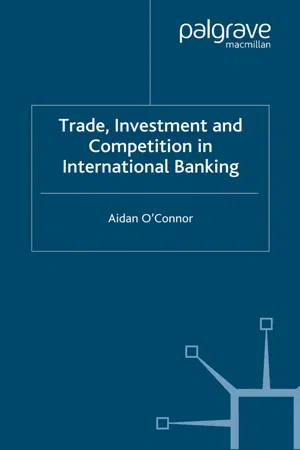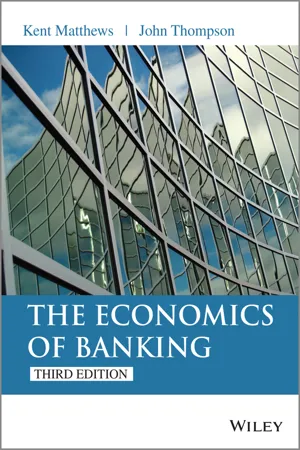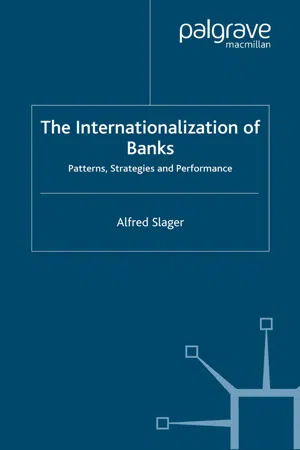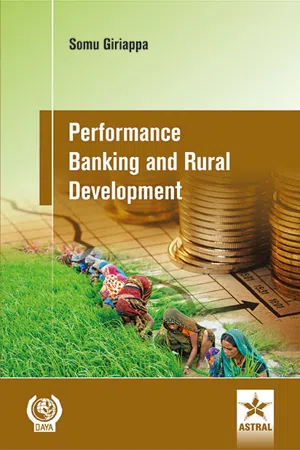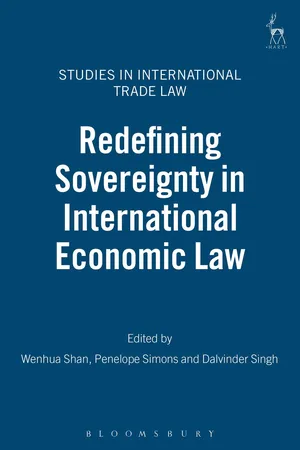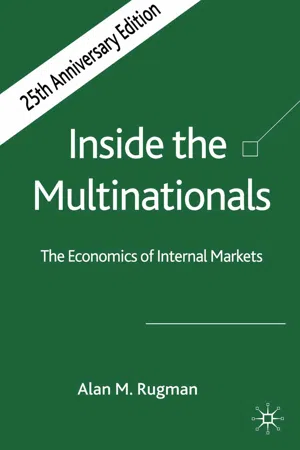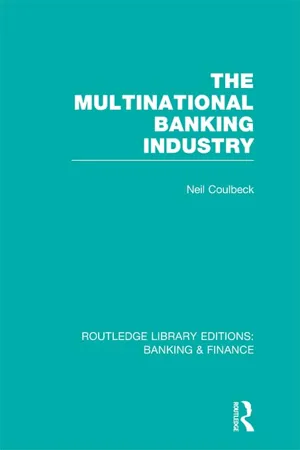Economics
International Banking
International banking refers to the provision of financial services by banks across national borders. This includes services such as trade finance, foreign exchange, and cross-border lending. International banks play a crucial role in facilitating global trade and investment by providing access to capital, managing currency risks, and supporting international business transactions.
Written by Perlego with AI-assistance
Related key terms
1 of 5
9 Key excerpts on "International Banking"
- A. O'Connor(Author)
- 2005(Publication Date)
- Palgrave Macmillan(Publisher)
The main features of the money market are that the instruments traded have short maturity and are highly liquid. Notwithstanding their market reach, and while a large proportion of cross-border transactions by commercial banks is inter-bank, almost all commercial banks could be described as international as they conduct international payments and settlements on behalf of customers. A basic service such as foreign exchange is also international as it is trans- acting in a foreign currency in the domestic market. When customers transact business in another country with credit and debit cards, either when abroad or through the use of telecommunications, this may be termed personal International Banking. Furthermore, most banks have an internet banking service and customers may transact banking services without being in the same country as the bank. The Scope of International Banking, Business Activities and Markets 125 Investment banks operate principally in the capital markets and focus on corporate customers, such as, firms, institutional investors, governments and public authorities. Their main activities are under- writing and market making of securities issues, advising on capital raising and mergers and acquisitions, securities trading and institu- tional and investment fund asset management. Some investment banks also offer asset management services to high net worth individu- als, which is often termed private banking when commercial banks provide this service. They are actively involved in wholesale banking markets. Commercial and investment banks are intermediaries. Commercial banks make loans and investment banks underwrite and distribute securities issues. The relationship with their respective customers differs in that commercial banks hold loans as assets on their balance sheets, unless these are later securitised, whereas investment banks sell on issues they underwrite to investors in primary markets and also trade in securities in secondary markets.- eBook - PDF
- Kent Matthews, John Thompson(Authors)
- 2014(Publication Date)
- Wiley(Publisher)
In the second category (i.e. global banking), the bank uses funds raised in the foreign market to finance claims in that foreign market. As McCauley et al. point out, the essential difference is that International Banking is cross-border banking, whereas global banking concentrates on serving local markets by raising funds locally. In the remainder of this chapter, the term ‘International Banking’ will be used to mean the first and more narrow definition. Another aspect of International Banking in the broad sense is eurocurrency business. A eurocurrency can be defined as a deposit or loan denominated in a currency other than that of the host country where the bank is physically located. Thus, for example, a deposit of yen in London is a eurocurrency, whereas a deposit of yen in Tokyo is not. It should be appreciated that eurocurrencies have nothing to do with the euro (the currency of the majority of the Eurozone countries). The term ‘eurocurrency’ is misleading in a second way, as the markets are not confined to Europe – see Section 5.3 for a discussion of the various International Banking centres. The eurocurrency markets account for about 80% of International Banking, so we concentrate on these markets later on in the chapter. The differences between the various types of international business can be further explained with reference to Table 5.1, which is adapted from McCauley et al. (2002, table, p. 42). The bank has its head office (HO) in the UK and has foreign assets comprising loans to borrowers in the EU. The bank can finance these loans in five ways. The first two consist of taking deposits in the UK and lending the funds on to the EU borrower via its EU banking affiliate. Most International Banking is of this form or a variation whereby the funds pass through a third country. In the third case a depositor in the EU lends to a UK bank that in turn lends to an EU firm. These three categories are classified as ‘international lending’. - eBook - PDF
The Internationalization of Banks
Patterns, Strategies and Performance
- Alfred Slager(Author)
- 2006(Publication Date)
- Palgrave Macmillan(Publisher)
Assets and/or liabilities other than in the home country and/or home country currency, A. Slager, The Internationalization of Banks © Alfred Slager 2006 2. rights and/or claims other than in the home country and/or home country currency, part of which is 3. issued and collected outside the home country. This definition agrees with the one the Bank of International Settle- ments (BIS) uses for International Banking statistics (Bank for Interna- tional Settlements, 2000) and is a slight expansion to the one given by Bryant (1987) and a broadening of Scholtens’ definition (1991): any financial transformation that has a cross currency and/or cross country dimension. A pragmatic definition stems from Casson who defined a multinational bank as a bank that owns and controls banking activities in two or more countries (Casson, 1990). Robinson defined multina- tional banking as “operating a bank in, and conducting banking opera- tions that derive from, many different countries and national systems” (Robinson, 1972). With each of these definitions off balance sheet activities as well as balance sheet activities are covered. Gray and Gray (1981) limited their definition to a financial corporation which acquires deposits and initiates loans from offices located in more than one country, excluding non-interest income. In theory, International Banking activities might be conducted in the home country when the financial intermediary only trades with other financial intermediaries who are active internationally. To exclude the possibility of a narrow interpretation of international financial inter- mediation a third condition has been added to the definition: there has to be actual cross border activity implying real changes within the organization. With regard to the internationalization part of the definition, no restrictions are formulated with regard to the number of countries or the type of activities. - eBook - PDF
- Giriappa, Somu(Authors)
- 2021(Publication Date)
- Daya Publishing House(Publisher)
Establishment of strong internal control systems and risk management system with monitoring and auditing facilities become crucial for effective supervision. Progress in Global Banking A shift away from International Banking to one of globalized banking during the last decade has changed the banking market significantly. Banks rather than taking deposits is one jurisdiction and lending in another could perceive the strategy of taking deposits and offering loan and mortgages within national markets through local presence. Some banks may perceive a This ebook is exclusively for this university only. Cannot be resold/distributed. capital market strategy wherein they may fund their portfolios of local securities locally as well. Thus banks are increasingly looking to serve customers through a local presence funded locally. The global or multinational bank differs from an international bank, which takes deposits in one country and makes loans in another. The difference between these two types of banking is the way in which foreign assets of a bank are financed. The foreign assets are its claims on borrowers dominated outside the market in which the bank is headquarted. An international bank uses funds raised in its domestic market to finance its claims and borrowers in a foreign bank. But a global bank uses funds raised in a foreign market to finance its claims and borrowers in the same foreign market. Whereas an international bank concentrates on cross-border business, a global banks focus is on serving local markets locally. In the case of International Banking for ex: funds are raised in the United States by taking deposits from US residents and then but to Japan (sometimes through a third country). In the case of global banking, funds are raised in Japan by the Japanese affiliate of a US bank and lent by the same affiliate to borrowers in Japan. Also, where the funds are raised abroad, the depositor rather than the bank loans the transfer risk. - eBook - PDF
- S. Janssen(Author)
- 2009(Publication Date)
- Palgrave Macmillan(Publisher)
It could be conjectured that a clear legal definition of a bank and other financial terms as found in German law could impede the flexibility which appears necessary in the face of the ever faster changes in economic reality. Therefore, the much deplored absence of a clear definition of a bank in the United Kingdom and the tradition of common law (see previous remarks by the Review Committee on Banking Services Law) may have contributed significantly to the faster adaptability of the British authorities. Whichever legal system seems to better adjust to the fast changing economic reality, either tends to react to economic reality, although its reactions may in return have repercussions for that economic reality. Thus, an economic definition What Is a Bank? 15 of a bank should be applicable across borders. The next section outlines the widely accepted microeconomic definition of a bank. 2.6 Microeconomic definition of a bank The preceding sections showed that the varying banking traditions in Britain and Germany prompted different organisational structures in the banking sector. While in the United Kingdom a dual structure with clear- ing banks (DTIs) and merchant banks (NDTIs) prevailed for many years, banks in Germany have traditionally been organised as universal banks. One important issue which emerges from these different organisational forms are the capital adequacy requirements for investment banks and retail banks. The different capital requirements for different types of banks pin- point the most prominent aspect of banking business, namely dealing with risk, which is defined as the deviation from the expected, that is the vari- ance of possible outcomes (Black, 1997, pp. 406–409). Investment banks assist third parties in the management of risk. The bulk of an investment bank’s revenues comprise non-interest income, such as commission fees and trading results, which are not determined by its bal- ance sheet structure. - eBook - PDF
- Bang Nam Jeon, Maria Pia Olivero, Bang Nam Jeon, Maria Pia Olivero(Authors)
- 2013(Publication Date)
- Emerald Group Publishing Limited(Publisher)
In a globalised world, lending may be provided both domestically, or internationally. Lending institutions may in turn fund their assets through deposits, or the issuance of securities in both domestic and international markets. Banks are motivated to internationalise to provide international services to their customers as well as to diversify balance sheet risks (e.g. Domenech & Correa-Lopez, 2012 ). In addition, Cetorelli and Goldberg (2012) show that having international operations insulates otherwise locally focused banks from changes in monetary policy shocks. Importantly, bank internationalisation has systemic risk implications, since banks may transmit financial shocks to their subsidiaries, as many are reliant upon internal as well as external funding (e.g. Jeon, Olivero, & Wu, 2013 ; Pontines & Siregar, 2012 ). The financial markets in which these banks operate are also becoming more integrated and sensitive to interna-tional business cycles ( Kalemli-Ozcan, Papaioannou, & Perri, 2013 ), and International Banking itself is concentrated through a small number of financial centres, especially London, which may exacerbate counterparty risks ( Clare, Gulamhussen, & Pinheiro, 2013 ). In this chapter we survey aggregate cross-border banking positions and focus on the relationship between international bank assets and liabilities as reported by the Bank for International Settlements (BIS). International asset and liabilities refer to reporting banks’ positions in any currency with non-residents (i.e. their external or cross-border business) plus their transactions in foreign (non-local) currency with residents, while ‘external’ positions or ‘cross-border’ positions are asset and liability positions vis-a` -vis banks and non-banks located in a country other than the country of residence of the reporting banking office positions ( BIS, 2008 ). Both may be received, or paid, in the form of deposits, or securities. - Wenhua Shan, Penelope Simons, Dalvinder Singh, Wenhua Shan, Penelope Simons, Dalvinder Singh(Authors)
- 2008(Publication Date)
- Hart Publishing(Publisher)
Part Four Banking Regulation and International Financial Institutions 12 Banking, Economic Development and the Law CHARLES CHATTERJEE AND ANNA LEFCOVITCH* INTRODUCTION T HE IMPORTANCE OF developing a strong capital market, including an efficient banking system, for a sustainable economy can hardly be over-emphasised, and yet many countries, particularly in the developing world, do not seem to have paid much attention to this matter. Absence of a strong and reliable financial market contributes to sluggish economies and dis-courages foreign investors from investing in those economies; the benefits of interaction with other economies are hardly derived by these stagnant economies. Heating-up of economies should be part of a government’s domestic eco-nomic policy, and in this respect, governments should closely work with their central banks. Without relying on any theoretical approach advocated by many economists on this issue, from a realistic standpoint, it may be stated that all economies move around a cycle: high employment provides incomes, incomes should lead to savings, and savings should raise the prospects of investment in a country. In this process, expansion of the domestic economy proves to be essen-tial as it provides the causal link between these essentials. Commercial banks in a country under the supervision of their central bank may directly contribute to the economic development process in a country. Not only does the banking structure in a financial market need to be improved but also the banking habit of peoples must be developed. It is the purpose of this chapter to examine how the two elements of: (a) bank-ing structure; and (b) banking habit, may be developed in a developing country. * The views expressed in this article are those of the authors, and in no way may be attributed to the institutions with which they are affiliated.- eBook - PDF
Inside the Multinationals 25th Anniversary Edition
The Economics of Internal Markets
- A. Rugman(Author)
- 2006(Publication Date)
- Palgrave Macmillan(Publisher)
The multinational bank also does better than a domestic bank. The latter is confined within a national currency area and is subject to the systematic risk of that economy. Opportunities for internalization are confined by the limited size of the domestic financial sector. Exogenous government regulations may constrain the scope of finan- cial intermediation by domestic banks. In contrast, the multinational bank can escape the specific risks and national banking regulations of any single nation. It can benefit from international diversification and engage in internalization to an extent denied the domestic bank. The process of international financial intermediation by multinational banks is efficient and their performance will reflect this efficiency. Finally, it is apparent that there are world welfare gains arising from the extent of multinational banking activity. It has long been held, in a domestic context, that financial intermediation helps to improve the efficiency of an economy and stimulates its development. Greater specialization is possible and the improved division of labour increases performance and net output for a nation. Similarly, on an international level, the same welfare gains will be available. The multinational bank is a vehicle for the international division of labour. It cannot maximize world welfare by itself, but it can assist this objective. The rise of multinational banks should also increase the degree of integration of world capital markets and help to improve their effi- ciency. The international financial markets and multinational banks are now inexorably intertwined. The theoretical rationale of the multinational enterprise, namely internalization, can be applied to explain the activities of the multinational bank. For these reasons the relationship between internalization and International Banking is likely to become an important subject for more detailed theoretical and empirical analysis in the future. - Neil S Coulbeck(Author)
- 2012(Publication Date)
- Routledge(Publisher)
Growth in gross foreign currency lending by Euro–banks (row 1). 2. Even stronger growth in international lending in domestic cur- rencies by banks in USA (row 4) and in other countries (row 5). 3. Equally strong growth in international lending in foreign cur- rencies by offshore branches of US banks (row 3). 4. Net international bank lending volumes. Clearly US banks play a dominant role, and the US dollar is the key currency, but the importance of lending by other international banks such as Canadians and Japanese is increasing. Foreign exchange markets complement the money and capital markets in financial centres, facilitating the flow of currencies between countries. They are an essential adjunct to the Eurocur- rency markets where borrowers and lenders are frequently dealing in foreign currencies. In terms of volume, the foreign exchange markets are much smaller than the bank deposit markets which form the basis of the Euromarkets, and so interest rates in the money markets will tend to influence exchange rates, rather than the other way round. Banks are the only direct participants in the foreign exchange Multinational Banking 61 markets, most importantly the commercial banks and the central banks. Commercial banks act on behalf of their customers, personal and business, to supply their foreign currency needs, and also need to satisfy their own foreign currency funding require- ments. They may also deal in the market to earn dealing profits through arbitrage and speculation. Central banks intervene in order to maintain orderly markets and to protect the value of the national currency. Banks of all kinds deal directly with each other or through brokers, by means of telephone and telex communica- tions, and via computer links. The instruments in this market are simply cash or bank deposits in the currency concerned, deliverable at agreed rates either after two days (spot market) or a longer predetermined period.
Index pages curate the most relevant extracts from our library of academic textbooks. They’ve been created using an in-house natural language model (NLM), each adding context and meaning to key research topics.
